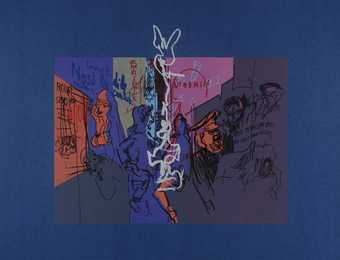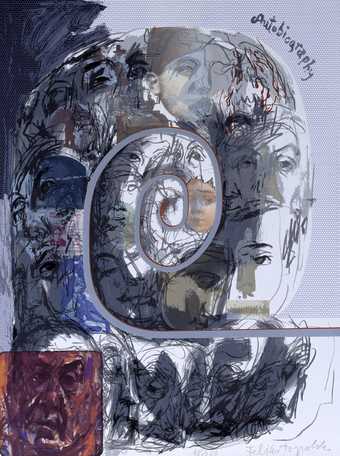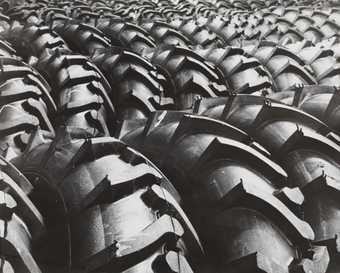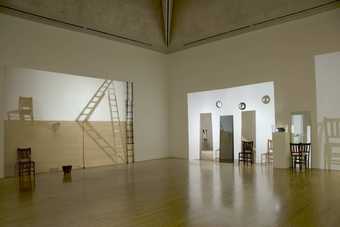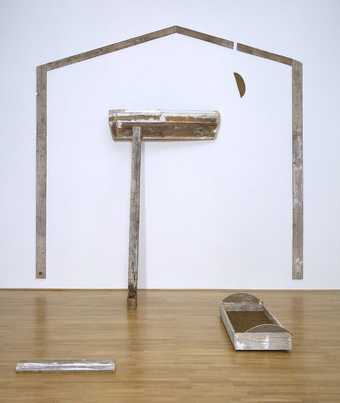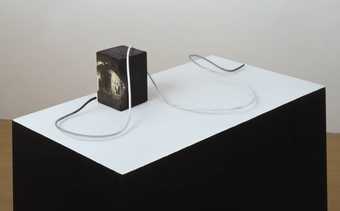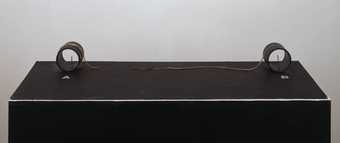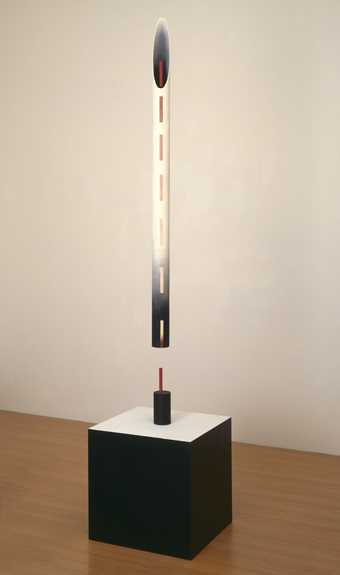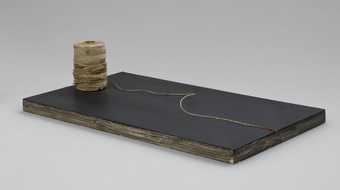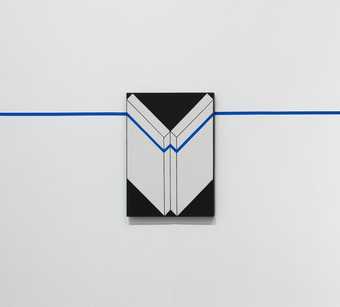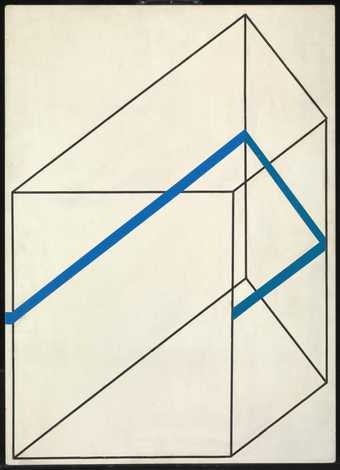
In Tate Modern
- Artist
- Edward Krasinski 1925–2004
- Original title
- Bez tytulu
- Medium
- 12 mirrors and tape
- Dimensions
- In twelve parts, each: 500 × 600 × 4 mm, 3 kg, overall display dimensions variable
- Collection
- Tate
- Acquisition
- Presented by Tate Members 2007
- Reference
- T12558
Summary
Untitled 2001 is a room installation consisting of twelve mirrors of equal size suspended from the ceiling, and Krasinski’s signature blue Scotch tape. A continuous strip of tape is stuck horizontally onto the walls of the room at a height of 130cm from the floor. The verso of each mirror, which is black, has also had a strip of blue scotch tape stuck to it, and the mirrors are hung so that the tape on their backs is also at a height of 130cm from the floor. The mirrors, all facing in the same direction, reflect the surrounding architecture, the black backs of the other mirrors with their blue strips, and the continuous blue strip on the wall. This creates the illusion of a space that both recedes and advances depending on the viewpoint of the visitor. Of course, viewers entering the visual field created by the mirrors are also reflected, and so may disrupt the real and reflected continuity of the blue line. T12558 was first installed in 2001 at the Klosterfelde Gallery, Berlin, alongside several untitled sculptural objects, including T12559, T12560, T12567 and T12624, which were exhibited on plinths of varying heights. Krasinski often included works he had produced in the 1960s and 1970s in his later installations, or incorporated photographs of them into his subsequent works (see T12559). The inclusion of older works within a newer installation creates a tension between the past and the present, whilst Krasinski’s use of mirrors, in conjunction with his signature blue tape, is part of his ongoing exploration of notions of infinity and space.
Krasinski first used the blue strip that would become his trademark in 1968. He progressed from simply sticking the strip in surprising places to making assemblage constructions that incorporated it. As he explained: ‘I wanted to “pull” something out of the wall; I framed parts of reality, like a fragment of my door with the handle and the frame and made a picture out of it’ (quoted in Breitwieser, p.22). For the Tokyo Biennale in 1970, Krasinski’s works were delayed in shipping. He sent a telex to the organisers containing the word ‘BLUE’ repeated 5000 times, along with instructions to display the roll of perforated telex paper with the code for the word ‘blue’ on it (reproduced in Breitwieser, p.182). After 1974, he turned away from assemblage constructions to concentrate on axonometric designs. As the critic Pawel Polit describes, Krasinski not only displayed these images in gallery spaces, but also in such unusual locations as a toilet, a bedroom in his own flat, a hospital, a pigsty and as butcher’s shop (Breitwieser, p.75). Krasinski remained reluctant to discuss the meaning of the tape, commenting: ‘The tape had ascribed meaning to itself. Once it came into being, it was then free to do anything, to frolic. The meaning is inherent in the tape; I inspired only its spirit.’ (Quoted in Breitweiser, p34.)
Born in Luck in the Ukraine, Krasinski studied Applied Arts and Fine Arts in Krakow, and began his career in the 1960s as a surrealist painter. In the early 1970s, he moved into Henryk Stazewski’s studio where they lived together, and remained there after Stazewski’s death in 1988. In 1966, Krasinski was one of the founders of the Foksal Gallery in Warsaw, which acted as a focal point for experimental conceptual artists. He participated in the first happening in Warsaw in 1965, initiated by the artist and theatre director Tadeusz Kantor (1915–90), and later played the role of conductor in Kantor’s Panoramic Sea Happening 1967 at Lazy, near Osieki. He began using blue tape in his actions, installations and photo-based works from 1968, often working with the photographer Eustachy Kossakowski (1925–2001). In 1970, he applied tape to the walls of the Musée d’art Moderne de la Ville de Paris and the windows of Rive Gauche galleries. He met Daniel Buren (born 1938) on that occasion, and the two artists remained friends. There is a strong conceptual likeness between the two artists’ work, as both use unchanging and potentially infinite stripes to challenge the definition of art and ways of looking at art (see Buren’s work T12316, One of the Possibilities 1973). Krasinski described the ambivalent and challenging meaning of his use of the blue tape, which became his signature mark: ‘Blue Scotch Tape, 19mm wide, length unknown. I place it horizontally at a height of 130cm everywhere and on everything. I encompass everything with it and go everywhere. This is art, or is it? Yet one thing is certain: blue Scotch Tape, 19mm wide, length unknown.’ (Quoted in Kiessler and Mytkowska, p.83.)
Further reading
Lena Kiessler and Joanna Mytkowska (eds.), Edward Krasinski: Interwencja, Warsaw 2001.
Sabine Breitwieser (ed.), Edward Krasinski: Les Mises en Scène, Vienna 2006.
Pawel Polit (ed.), Edward Krasinski: Elementarz/ABC, Krakow 2008.
Elizaveta Butakova
March 2010
Supported by the London Centre for Arts and Cultural Exchange in collaboration with the Courtauld Institute of Art.
Does this text contain inaccurate information or language that you feel we should improve or change? We would like to hear from you.
Explore
- emotions, concepts and ideas(16,416)
-
- formal qualities(12,454)
-
- space(177)
- visual illusion(118)
- furnishings(3,081)
-
- mirror(241)
- tape(5)
You might like
-
Feliks Topolski Piccadilly Circus
1973 -
Feliks Topolski Autobiography
1973 -
Tadeusz Suminski Tyres, Debica
1963 -
Felicia Leirner Composition
1962 -
Tim Head Displacements
1975–6 -
Miroslaw Balka Fire Place
1986 -
Miroslaw Balka Oasis (C.D.F.)
1989 -
Edward Krasinski Untitled
1968 -
Edward Krasinski Untitled
1968 -
Edward Krasinski Untitled
1965 -
Edward Krasinski Untitled
1969, reconstructed 1978 -
Edward Krasinski Intervention 15
1975 -
Edward Krasinski Intervention 27
1975 -
Ewa Partum Active Poetry
1971–3

